The Japanese Yokosuka MXY7 Ohka (“Cherry Blossom”) was a piloted, rocket powered, anti-shipping Kamikaze suicide aircraft with a 1,200 kg / 2,646 lb ammonal warhead designed to unleash hell upon Allied fleets. The Ohka was essentially a piloted missile… absolute pure madness!

Kamikaze
Yokosuka MXY7 Ohka were deployed by the Imperial Japanese Navy for use by Kamikaze units towards the end of World War Two. This was a time of desperation and a nearing defeat for the Japanese. Kamikaze is Japanese for “Spirit Wind” or “Divine Wind” and the Kamikaze units were officially titled Tokubetsu Kōgekitai (“Special Attack Unit”). As skilled pilot numbers and quality combat aircraft diminished with loss after loss against superior Allied numbers and equipment, the Japanese turned to a perceived way to put unskilled pilots to maximum use flying obsolete aircraft packed with high explosives, bombs and fuel as suicide pilots. Captain Motoharu Okamura, a distinguished Japanese military aviator and commander of the 341st Tateyama Kōkūtai (Air Group) in June 1944 is said to have first come up with the Kamikaze concept and develop training programs for attacking Allied shipping.
“I firmly believe that the only way to swing the war in our favour is to resort to crash-dive attacks with our planes…. There will be more than enough volunteers for this chance to save our country.” – Captain Motoharu Okamura
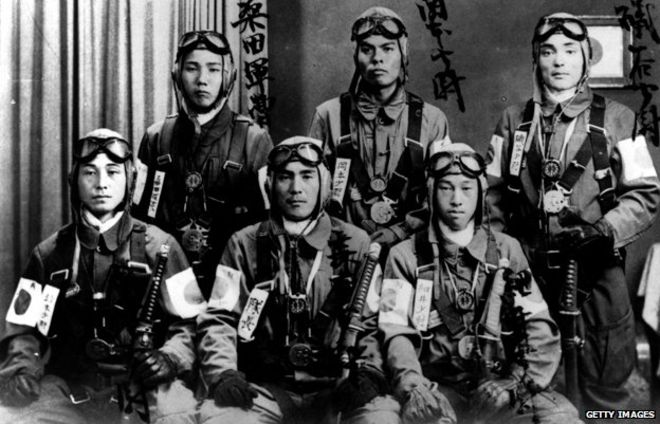
Anywhere up to 4,000 Kamikaze pilots, mostly aged between 18 and 24 years old, senselessly died whilst leaving havoc and destruction in their wake during the final months of World War Two striking 474 Allied ships and killing 7,000 servicemen (a great expense in thousands of men and 2,500 aircraft for a relatively limited and wasteful 19% success rate per sortie according to Kamikaze: Japanese Special Attack Weapons 1944-45 by Steven J. Zaloga, Pg. 12). The first official organised Kamikaze attacks by the Japanese are said to have happened during the period of October 23rd – 26th, 1944 at the Battle of Leyte Gulf near the Philippines by 24 volunteer pilots of the 201st Navy Air Group, against a combined Australian and US naval force.

The first major warship lost to a Kamikaze attack was the escort carrier USS St. Lo (CVE-63) struck by an Mitsubishi A6M Zero fighter at the Battle of Leyte Gulf on October 25th, 1944. Despite the battle ending in a resounding Allied victory, the relative success of this small Kamikaze group lead the Japanese commanders to support further attacks (the Japanese Imperial Army also conducted Kamikaze attacks during these final months of the war).
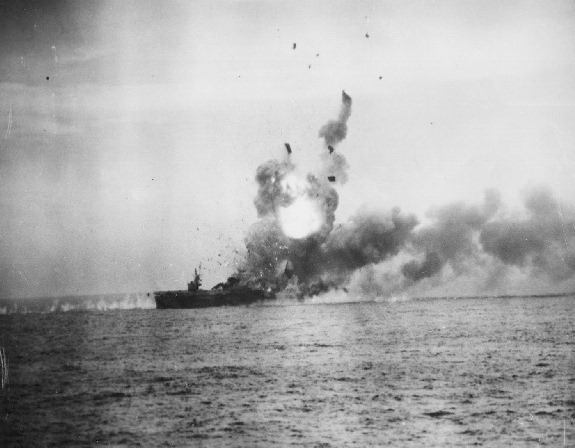
The Battle of Iwo Jima (19 February 19th – March 26th, 1945) saw further Kamikaze attacks which managed to sink the escort carrier USS Bismarck Sea (CVE-95) on February 21st, 1945 (with a heavy loss of crew, this became the last US Navy aircraft carrier sunk during World War Two) and cripple the carrier USS Saratoga (CV-3). During the Battle of Okinawa (March 26th, 1945 – June 22nd, 1945), Kamikaze attacks sunk 17 US Navy vessels and damaged 279 others (Kamikaze: Japanese Special Attack Weapons 1944-45 by Steven J. Zaloga, Pg.12) which sadly resulted in the death of more than 3,000 US Navy crew members plus wounding at least 6,000 more. Despite the losses these battles were another resounding Allied victory and a key part in the final fatal blows against Imperial Japan.

Enter the Ohka
The Yokosuka MXY7 Ohka was first tested by the Japanese in unpowered flight in October 1944 and powered flight in November 1944. The type was introduced into Imperial Japanese Navy operational service in 1945 and 852 were manufactured. The Model 11 type was the only one to be used operationally (around 755 of the overall total manufactured). Little training was required to fly the Ohka has it had limited controls and only one or two training flights were required before the poor Kamikaze pilot was ready to go on a one way mission (a two-seat and single seat training variant were developed – see below). It was seen as an inexpensive and easy to produce aircraft to strike back at the Allies (regardless of the loss of pilots) and with its speed and small size making it more difficult to hit, it was going to be more effective than using existing and dwindling numbers of obsolete aircraft that were already part of the Kamikaze war (this was not necessarily the case as it turned out).

The Ohka was mainly used against US Navy ships during the 1945 Battle of Okinawa. They were generally carried to within range of a target (37 km / 23 miles) by an Imperial Japanese Navy Mitsubishi G4M2e Model 24 Tei “Betty” bomber (a modified version of G4M2a Model 24 Otsu and 24 Hei bombers to carry the Okha rocket. They were also fitted with additional armour for the pilot and fuel tanks to protect them upon an attack approach) then dropped to glide towards the designated target before igniting its rocket engines for a high-speed diving attack on a ship. It was also planned to be able to launch later Okha variants from land based catapults (from caves and airbases) if an Allied invasion occurred on the Japanese home islands (Operation Olympic was the proposed Allied invasion of Kyushu Island). Thousands of Kamikaze aircraft of all types (basically anything that could fly) were prepared for this final battle that fortunately never eventuated.
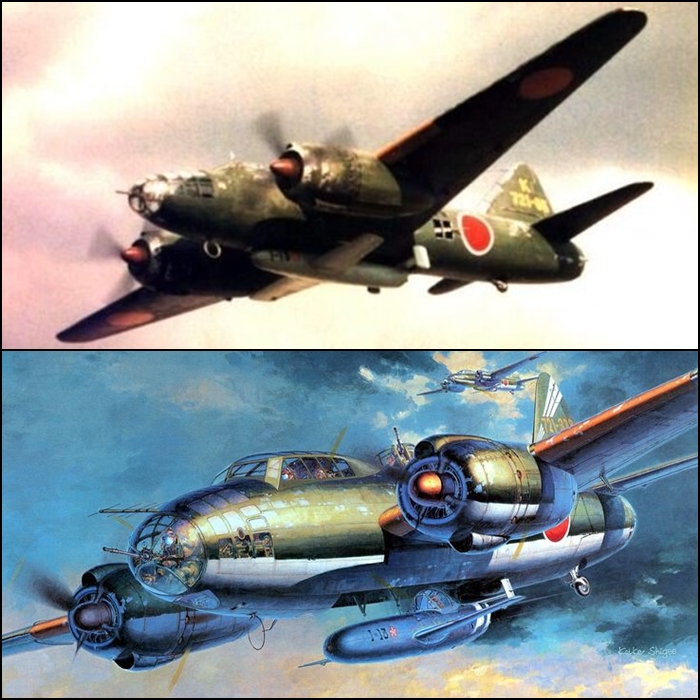

The Ohka Model 11 had a limited range of only around 37 km / 23 miles (the short-range made the bomber carrying the Ohka highly vulnerable to air attack which proved to be a major tactical problem). It would travel most of this distance in an unpowered glide from launch, with about 10 seconds of rocket thrust to reach an impressive speed of up to 990 km/h / 615 mph in a powered dive for the final attack (potentially making it very hard to hit with anti-aircraft fire). It was powered by three Type 4 Mark 1 Model 20 solid fuel rockets with a total thrust of 1,764 lbs (they could be fired one at a time or all three in unison).
On March 21st, 1945 the Ohka made its combat debut at Okinawa but this ended in disaster when the 16 “Betty” bombers carrying them were all shot down by US Navy Grumman F6F Hellcat fighters before they could be launched (caught too far out of range). On April 1st, 1945 an Ohka was thought to be successful in partially damaging a gun turret on the US Navy battleship USS West Virginia (BB-48) off Okinawa. Transport ships were also hit during the same Kamikaze attack but it was uncertain whether these were Ohka’s or other Japanese aircraft. The first US Navy ship sunk by an Ohka was the destroyer USS Mannert L. Abele (DD-733) on April 12th, 1945 during the Battle of Okinawa.
The US Navy soon extended a defensive perimeter around the fleet with ships providing heavy anti-aircraft fire and combat air patrols to target the “Betty” bombers and take out the Ohka’s before they could be launched. Further ships were damaged in Ohka attacks at Okinawa but no capital ships were badly damaged yet alone destroyed and the overall impact of the Kamikaze attacks using the rocket powered Ohka were deemed negligible in the battle. The US Navy nicknamed the Ohka the derogatory “Baka Bomb”, where Baka means “idiot” or “fool” in Japanese!

According to the Yanks Air Museum most Ohka’s were destroyed on the ground or when the “Betty” bomber carrying them was shot down. Less than 60 Okha’s are thought to have been used in actual combat. Others were also lost whilst being transported by Japanese aircraft carriers that were sunk by US Navy submarines.
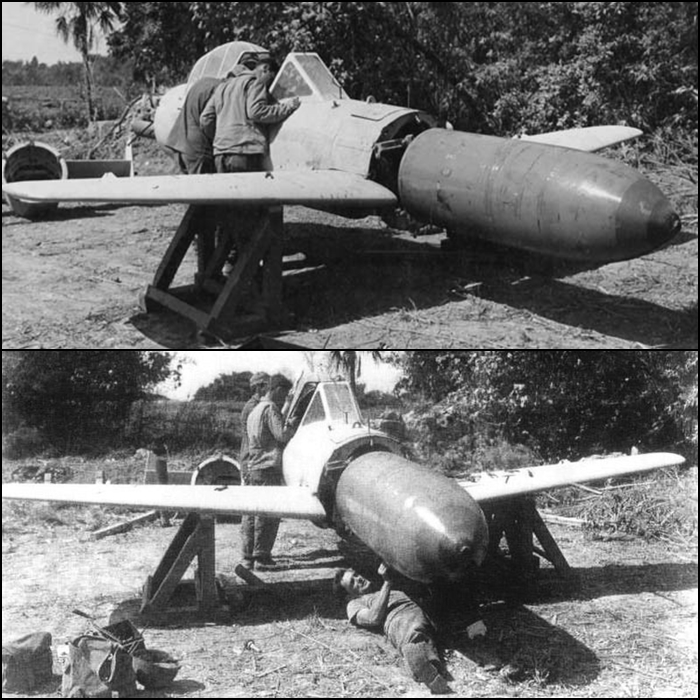
Surviving Ohka Aircraft
Only a few of the hundreds of Yokosuka MXY7 Ohka manufactured during World War Two survive today. Places I have seen an original Ohka on display include:
The National Museum of the US Navy which is located in the Washington Navy Yards, Washington DC (on base) impressively displays a US Navy Vought F4U-4 Corsair fighter alongside a Yokosuka MXY7-K1 trainer suspended from the ceiling. The trainer variant was carried aloft then released for practice flights to train Model 11 Ohka pilots. Unlike the Model 11 which was designed for a one way journey, the trainer had a landing skid and flaps to aid landing (ballast replaced the explosive in the nose). It was tricky to fly and land by all accounts. 45 MXY7-K1 trainers were manufactured by 1945.
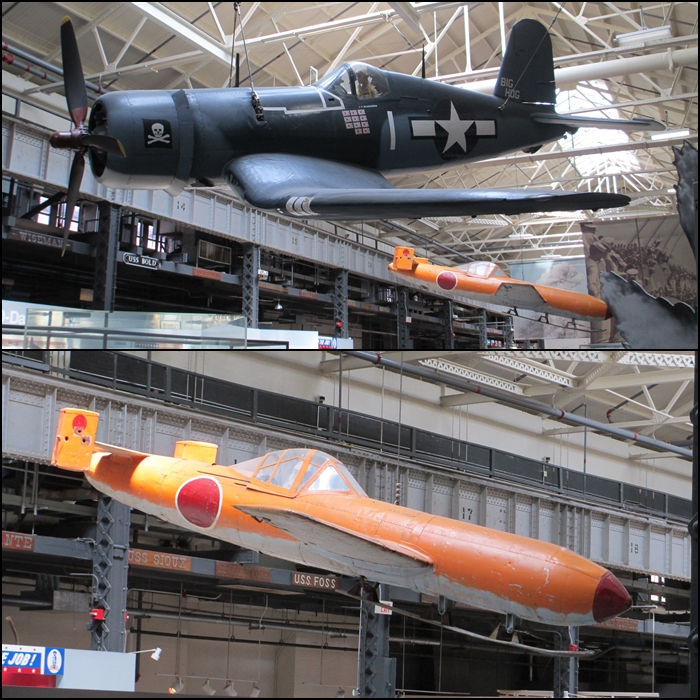
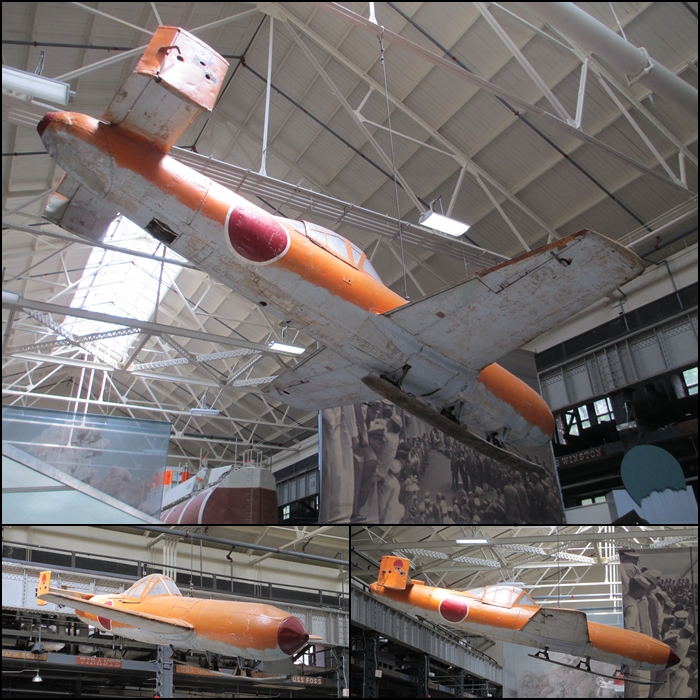
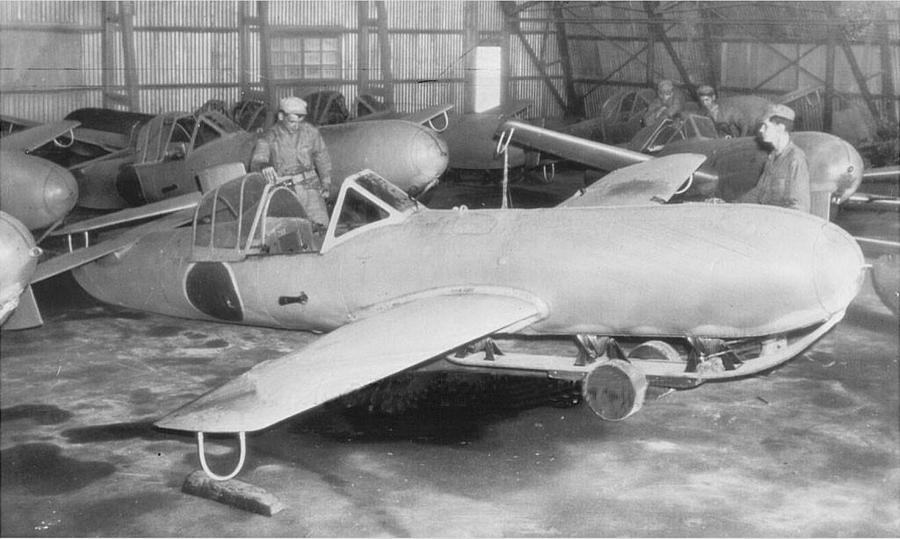
The National Museum of the USAF in Dayton, Ohio also displays a Yokosuka MXY7-K1 trainer. They have a good collection of Japanese World War Two aircraft on display within the Air Power Gallery (WW2).

The Planes of Fame Museum and Yanks Air Museum both display a Yokosuka MXY7 Model 11 Ohka and are both located at the airport in Chino, California. Yanks has Number I-10 captured on Okinawa in 1945 and Planes of Fame has Number I-18, which was captured at Yontan Airfield, Okinawa in 1945. The Model 11 does not have the landing skid as they were never intended to land once launched. The Planes of Fame Museum in particular has an impressive collection of Imperial Japanese Army and Navy aircraft from World War Two.
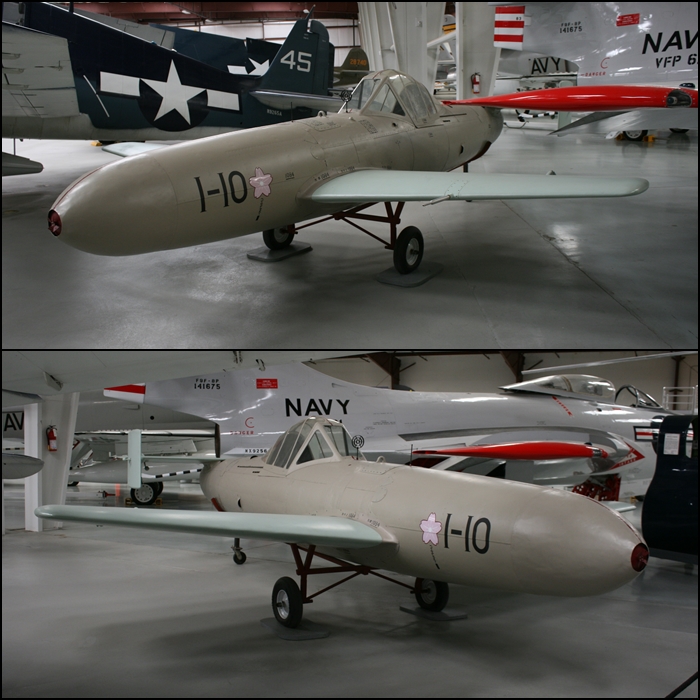

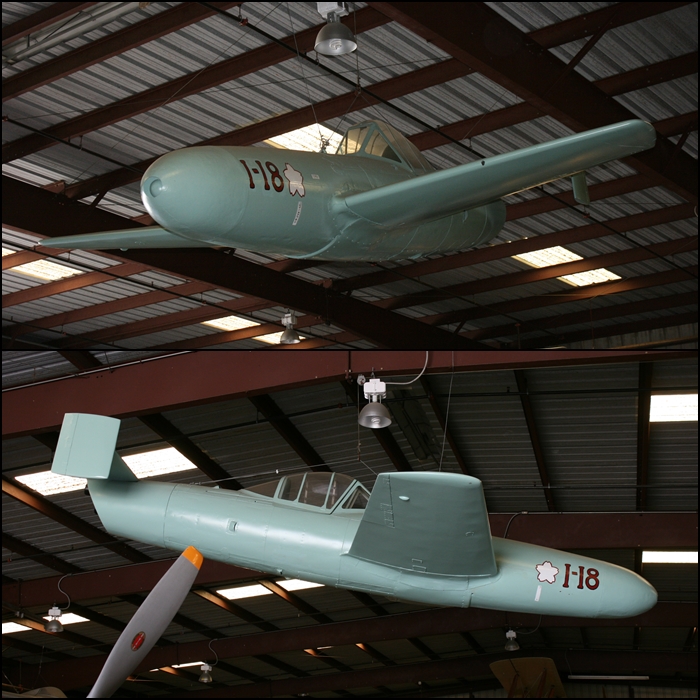

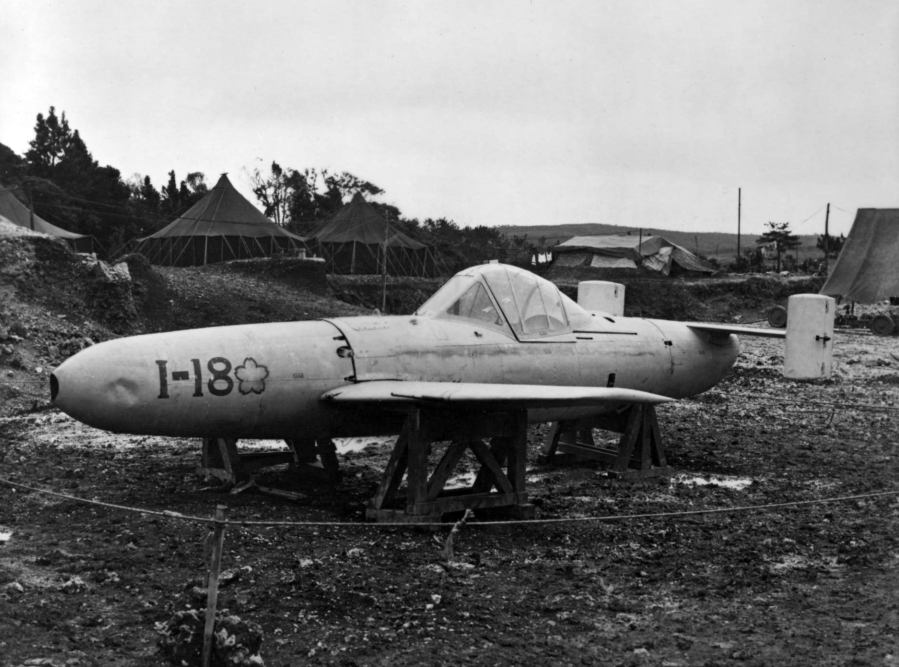
The Steven F. Udvar-Hazy Centre (an annex of the Smithsonian National Air and Space Museum) at Washington Dulles International Airport in Chantilly, Virginia displays a Yokosuka MXY7 Model 22 Ohka. This is a thermo-jet powered variant (Ishikawajima Tsu-11 engine) of which 50 were built and were intended to be launched from Yokosuka P1Y Ginga “Galaxy” bombers. It was recovered in Japan in 1945 and the type never saw operational service. This was lucky for the Allies as the Model 22 had an increased range boosted to about 130 km / 81 miles (the warhead size was reduced to 600 kg / 1,323 lb) which would have enabled launches much further from target, reducing the risk to the launching bomber (the Model 11 only had a range of about 37 km / 23 miles). This museum also holds an impressive collection of Imperial Japanese Army and Navy aircraft from World War Two.


Of the ones I have not seen in person:
The Smithsonian National Air and Space Museum on The Mall in Washington DC holds a two-seat trainer Yokosuka MXY7-K2 Kai Model 43B in its collection, which is apparently in poor condition and missing its wings (the last of its kind). Other original Yokosuka MXY7 Model 11 Ohka survivors can be found in India (1), Japan (2), the UK (4) and 1 at the USMC Air-Ground Museum in Quantico, Virginia.
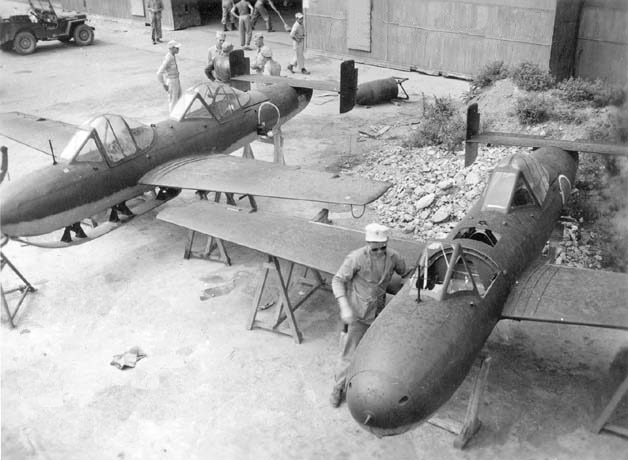
Germany, not known for suicide attacks but also facing desperate times and total defeat late in World War Two worked on a similar concept in the form of the Fieseler Fi 103R Reichenberg which was a manned variant of the V-1 flying bomb. More on the Fi 103R in my next post.
References:
First Kamikaze Attack – History.com
Kamikaze: Japanese Special Attack Weapons 1944-45 by Steven J. Zaloga
Smithsonian National Air & Space Museum (1)
Smithsonian National Air & Space Museum (2)

Impressive!
LikeLiked by 1 person
Reblogged this on Lest We Forget and commented:
If you haven’t yet discover this blog…
LikeLiked by 1 person
This always strikes me as a really dumb smart bomb!
LikeLiked by 1 person
Very true – “Baka Bomb” was the perfect nickname!
LikeLike
[…] facing desperate times and total defeat late in World War Two developed a similar concept to the Japanese Yokosuka MXY7 Ohka piloted Kamikaze anti-shipping rocket, in the form of the Argus pulse jet powered Fieseler Fi […]
LikeLiked by 1 person
Very informative, Deano. I didn’t know that the kamikaze campaign began so late in the war. I thought it had been a part of the Japanese strategy all the way through.
LikeLiked by 1 person
Thanks. Wave attacks by soldiers were pretty common earlier but highly trained and skilled pilots were the modern day samurai and highly regarded but as their numbers started to thin and things got desperate…
LikeLiked by 1 person
My father, William L. Watson, was one of the 4 soldiers with the captured I-10, pictured on this blog. If anyone knows the identity of any of the other 3 gentlemen, please post a comment, or contact me at philipwatson@mac.com.
LikeLiked by 1 person
I have a photo of my father (and a highschool classmate he happened to meet on Okinawa, neither knowing that the other was on the island) standing next to I-18; my dad’s photo does not show the number — they’re standing in front of it — but that dent shown on the left side of the front of I-18’s nose cone is clearly shown on my dad’s photos. My dad’s tent on Yontan Air Field is shown in the background of the photo of I-18 as well.
But that doesn’t help you much with identifying people from I-10, unfortunately.
LikeLiked by 1 person
[…] https://acesflyinghigh.wordpress.com/2015/09/02/yokosuka-mxy7-ohka-the-height-of-kamikaze-madness-in… […]
LikeLike
[…] তার প্রমাণ হলো তাদের উদ্ভাবিত এই ‘ইয়োকোসুকা MXY-7‘ মডেলের ওহকা কামিকাজি বোমারু বিমান, […]
LikeLike
Update on the Smithsonian’s MXY-7 K-2 Model 43: the aircraft is now on loan at the Pima Air and Space Museum in Tuscon Arizona. While the Smithsonian insisted on keeping the fuselage original, they allowed Pima to fabricate new wings, canopies, and tail controls, since only the fuselage remained intact.
LikeLiked by 1 person
Interesting. Thanks for the update
LikeLike